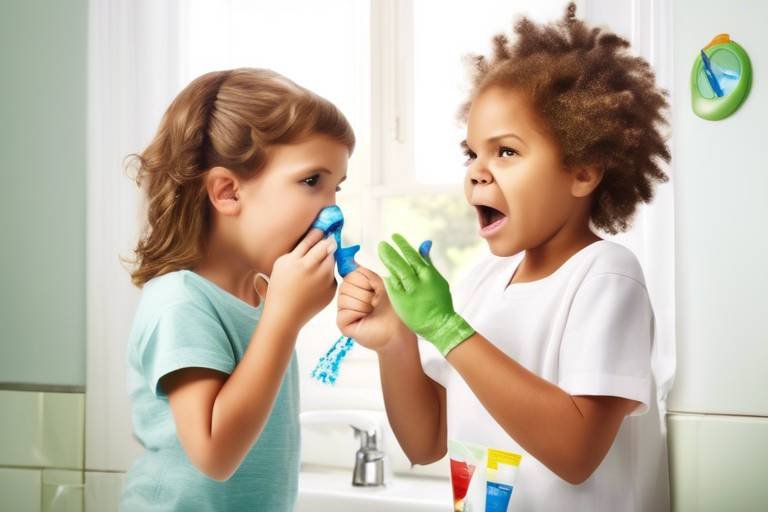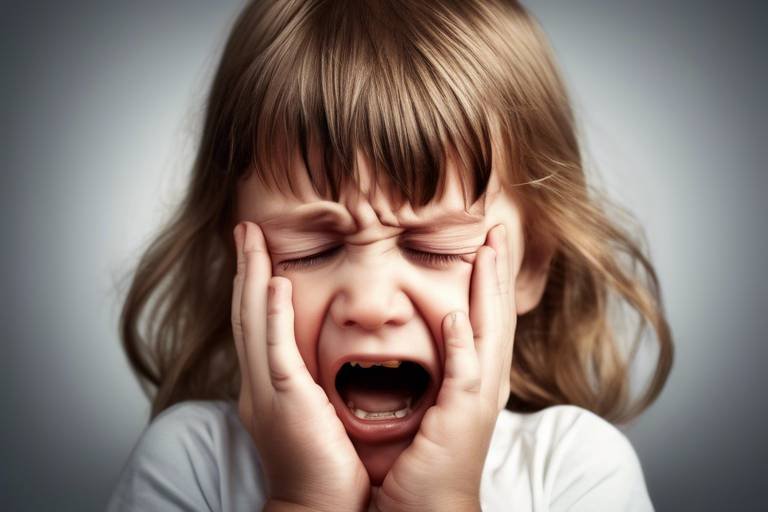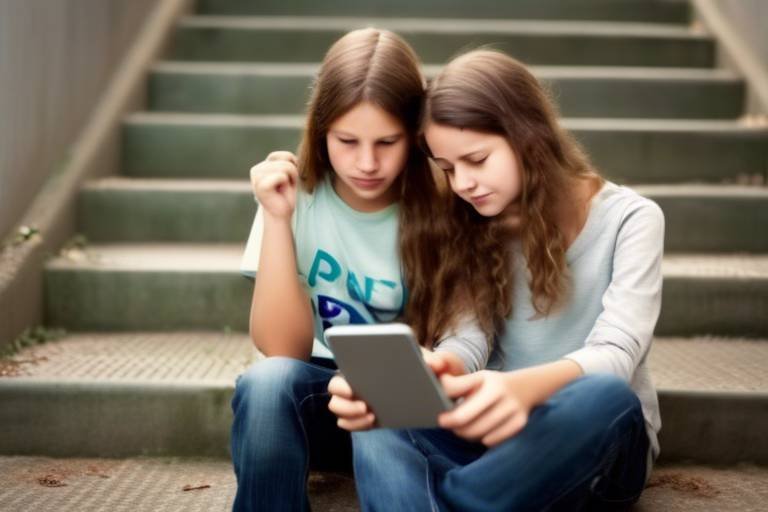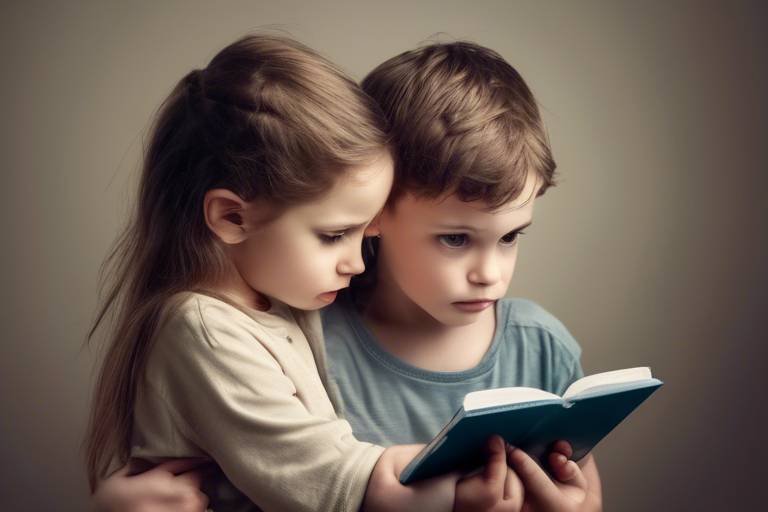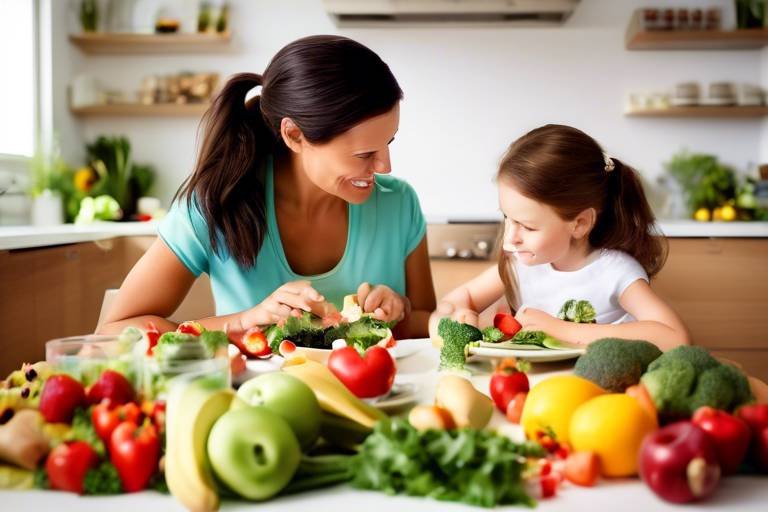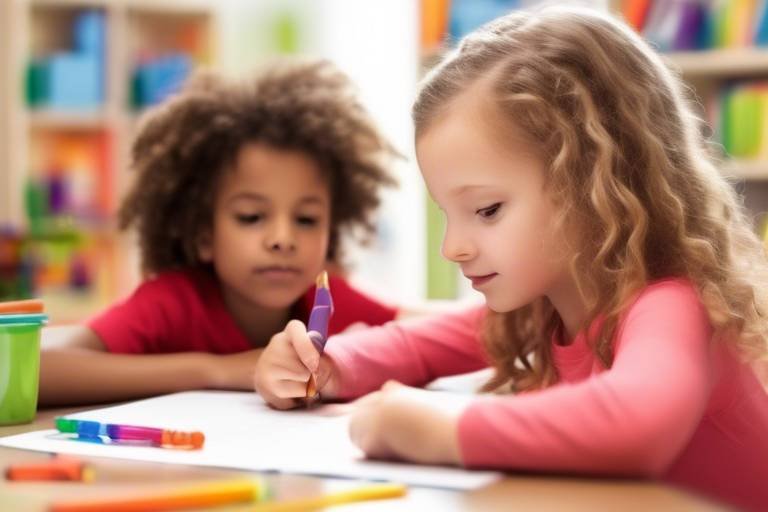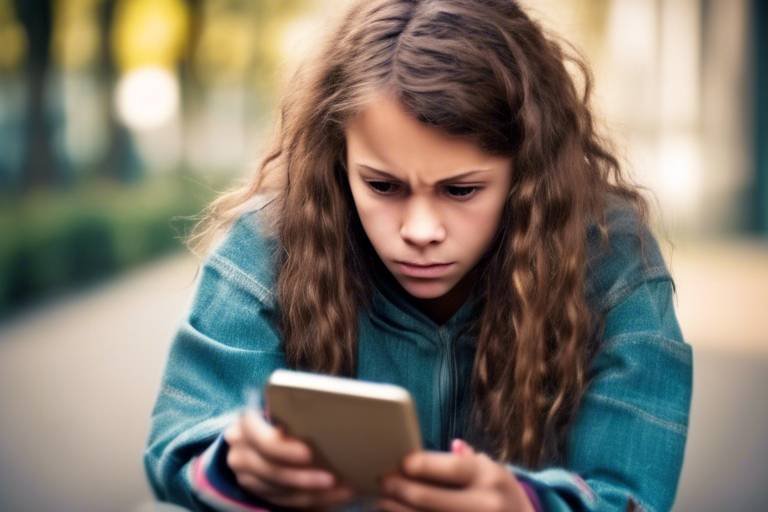Family Health: Teaching Kids About Germs and Hygiene
In today's fast-paced world, maintaining family health is more crucial than ever, especially when it comes to teaching our kids about germs and hygiene. Have you ever thought about how many germs are lurking around us? From the playground to the dinner table, these tiny invaders can be sneaky, and without the right education, children may not grasp the importance of staying clean and healthy. This article will explore effective methods for educating children about germs and hygiene, emphasizing the importance of instilling healthy habits from a young age to promote lifelong wellness.
So, what exactly are germs? Germs are microscopic organisms that exist all around us, and they come in various types, including bacteria, viruses, fungi, and protozoa. While some of these germs can make us sick, others are actually beneficial and help our bodies function properly. To give children a basic understanding of this invisible world, we can explain that germs are like tiny ninjas—some are out to get us, while others are our allies. By demystifying germs, we can help kids understand that while they may be everywhere, we have the power to protect ourselves through good hygiene practices.
Why is hygiene so crucial? Well, think of hygiene as your personal shield against illness. Good hygiene practices can significantly reduce the risk of infections and illnesses, allowing us to live healthier, happier lives. When children learn the importance of washing their hands, brushing their teeth, and bathing regularly, they're not just following rules—they're building a strong foundation for their health. In fact, studies show that proper handwashing can reduce the spread of respiratory illnesses by up to 21%! This means that teaching kids about hygiene is not just a chore; it’s a vital life skill that will benefit them for years to come.
Now, let’s dive into the nitty-gritty of handwashing! Teaching children the proper way to wash their hands is essential. Here’s a simple yet effective technique to share with them:
- Wet your hands with clean, running water (warm or cold).
- Apply soap and lather up for at least 20 seconds—don’t forget the back of your hands, between your fingers, and under your nails!
- Rinse well under clean, running water.
- Dry your hands using a clean towel or air dry them.
To make handwashing fun, consider turning it into a game. You can even set a timer or use a sand timer to help them understand how long 20 seconds really is. With a bit of creativity, handwashing can become a delightful part of their routine!
One of the best ways to make handwashing enjoyable is by incorporating catchy songs. Singing a little ditty while washing hands can make the process more memorable. Here are a couple of fun songs you can use:
- The "Happy Birthday" song (sung twice)
- "Twinkle, Twinkle, Little Star"
These tunes not only help kids keep track of time but also make handwashing feel like a fun activity rather than a chore.
Visual aids can play a significant role in reinforcing handwashing techniques. Consider creating colorful charts or illustrations that depict each step clearly. These visuals can be placed in bathrooms or kitchens as constant reminders. A simple chart with pictures can help children remember the steps and make the learning process engaging.
It's essential to address common misconceptions children might have about germs. For instance, many kids believe that all germs are bad, but that’s not true! Educating them about the difference between good and bad germs can lead to informed discussions about health. For example, explaining that our bodies need certain bacteria to help digest food can help clarify misunderstandings and promote a balanced view of germs.
Establishing daily hygiene routines is vital for reinforcing these lessons. Consistency is key in helping kids develop lifelong healthy habits. Parents can create a checklist of daily hygiene tasks, such as brushing teeth, washing hands before meals, and bathing regularly. This not only helps children remember but also instills a sense of responsibility for their health.
Remember, children are like little sponges—they soak up everything we do! By modeling good hygiene behavior, parents can lead by example. If kids see their parents washing hands regularly, it reinforces the idea that hygiene is important. It’s like planting seeds in a garden; the more you nurture them, the more they grow!
Lastly, let’s talk about the fun stuff! Incorporating hygiene education into play can make learning enjoyable. Consider organizing games that involve “germ hunts,” where kids can search for hidden “germs” (like small balls or toys) and learn about the importance of cleanliness in the process. This playful approach not only enhances retention but also makes hygiene education a delightful experience.
Q: How often should my child wash their hands?
A: Children should wash their hands before meals, after using the restroom, and after playing outside or with pets.
Q: What should I do if my child refuses to wash their hands?
A: Make it a fun activity! Use songs, games, or even colorful soaps to encourage them to wash their hands.
Q: Are all germs harmful?
A: No! While some germs can cause illness, many are beneficial and help our bodies function properly.

Understanding Germs
Germs are like tiny ninjas that are all around us, lurking in the shadows, invisible to our eyes. They are microscopic organisms that can be found everywhere—in the air we breathe, on the surfaces we touch, and even on our own bodies! While some germs are harmless, others can cause illnesses that can make us feel pretty crummy. Understanding what these germs are and how they operate is crucial for children as they navigate their daily lives.
So, what exactly are germs? They can be broadly categorized into four main types:
- Bacteria: These are single-celled organisms that can be beneficial or harmful. For instance, some bacteria in our gut help with digestion, while others can lead to infections.
- Viruses: Much smaller than bacteria, viruses need a host to replicate. They can cause illnesses like the common cold or flu.
- Fungi: These include molds and yeasts, which can sometimes cause skin infections or allergies.
- Protozoa: These are more complex single-celled organisms that can be found in water and can cause diseases like malaria.
Now, you might be wondering, how do these germs affect our health? Well, when germs enter our body, they can multiply and disrupt normal bodily functions. This is why it's essential to teach kids about hygiene—so they can learn how to protect themselves from these pesky invaders. For example, washing hands regularly can significantly reduce the chances of getting sick. It's like putting on an invisible shield that keeps germs at bay!
Furthermore, children should be made aware that not all germs are bad. In fact, our bodies are home to trillions of bacteria, many of which play a vital role in keeping us healthy. This dual nature of germs can be a fascinating topic for kids. By understanding both the good and bad aspects of germs, they can develop a balanced view of hygiene and health. It's similar to how we learn about fire; while it can be dangerous, it can also provide warmth and cook our food. Teaching kids about germs can empower them to make informed choices about their health.
In summary, understanding germs is the first step in promoting good hygiene practices among children. By making them aware of the different types of germs and their effects on health, we can help them develop a healthy respect for cleanliness and wellness. This knowledge will not only keep them safe but also instill habits that can last a lifetime.

The Importance of Hygiene
When it comes to health, hygiene is like the superhero cape that protects us from the invisible villains lurking around us—germs! Teaching children the significance of hygiene is crucial, not just for their immediate health, but for instilling lifelong habits that can keep them safe from illnesses. Imagine a world where every child understands that washing their hands can prevent colds or that brushing their teeth can keep cavities at bay. This understanding is the first step toward a healthier future.
Good hygiene practices are essential for several reasons. First and foremost, they play a significant role in preventing illness. When kids know how to wash their hands properly, they can significantly reduce the risk of infections. In fact, studies show that proper handwashing can decrease the likelihood of respiratory illnesses by up to 21%! Isn’t that a compelling reason to make it a daily habit?
Moreover, maintaining hygiene contributes to overall well-being. It’s not just about avoiding sickness; it’s also about feeling good. Good hygiene practices can boost self-esteem and confidence in children. Think about it—who doesn’t feel great after a refreshing shower or having clean, brushed teeth? When children feel good about themselves, they’re more likely to engage socially and participate in activities, which is vital for their development.
Let’s not forget about the social aspect of hygiene. Children are keen observers and often mimic the behaviors of those around them. When they see their peers practicing good hygiene, they’re more likely to follow suit. This creates a ripple effect, promoting a culture of health and cleanliness among friends and family. It’s like planting seeds of good habits that can grow into a beautiful garden of wellness!
In addition to individual benefits, good hygiene practices can have a positive impact on the community. When children practice hygiene, they help to reduce the spread of germs, which is especially important in places like schools and playgrounds where many kids gather. This collective effort can lead to a healthier environment for everyone. Just think of it as a team sport where everyone plays a part in keeping the team healthy!
To wrap it up, instilling the importance of hygiene in children is vital for their health, confidence, and social interactions. By teaching them about the role hygiene plays in preventing illness and promoting well-being, we are equipping them with the tools they need to thrive. So, let’s embrace hygiene as a fundamental part of our daily lives and encourage our kids to do the same. After all, a little soap and water can go a long way!
- Why is handwashing important? Handwashing is crucial because it helps remove germs that can cause illness. Regular handwashing can significantly reduce the risk of infections.
- How often should children wash their hands? Children should wash their hands after using the bathroom, before eating, and after playing outside or touching surfaces that may be dirty.
- What are some fun ways to teach kids about hygiene? You can incorporate songs, games, and colorful charts to make learning about hygiene engaging and enjoyable for children.
- How can I encourage my child to maintain good hygiene? Model good hygiene behaviors yourself, create a routine, and use positive reinforcement to encourage your child to stick to healthy habits.

Handwashing Techniques
Teaching children the proper way to wash their hands is not just about cleanliness; it’s about instilling a habit that can protect them from illness. Handwashing is like a superhero's power—simple yet incredibly effective! To help kids grasp the importance of this practice, we need to break it down into easy-to-follow steps. The Centers for Disease Control and Prevention (CDC) recommends washing hands for at least 20 seconds to effectively eliminate germs. But how can we make this process engaging for our little ones?
First, let’s talk about the technique. Here’s a step-by-step guide that you can share with your kids:
| Step | Action |
|---|---|
| 1 | Wet your hands with clean, running water (warm or cold). |
| 2 | Apply soap and lather up, making sure to cover all surfaces. |
| 3 | Rub your hands together for at least 20 seconds. Don't forget the backs of your hands, between your fingers, and under your nails! |
| 4 | Rinse your hands well under clean, running water. |
| 5 | Dry your hands using a clean towel or air dry them. |
Now that we have the steps down, let’s spice things up! Kids love songs, and what better way to make handwashing fun than by singing while they scrub? You can encourage them to sing their favorite tunes or even create a handwashing jingle. Here’s a catchy little rhyme you can teach them:
"Wash, wash, wash your hands,
Keep them nice and clean,
Scrub them here and scrub them there,
Germs are never seen!"
Visual aids can also play a huge role in making handwashing memorable. Consider creating colorful posters that illustrate the steps of washing hands. Hang these in your bathroom or kitchen as a friendly reminder. Kids are naturally visual learners, and seeing the steps laid out can reinforce their understanding.
By making handwashing a fun and engaging activity, we not only teach kids about hygiene but also empower them to take charge of their health. Remember, the goal is to create a habit that sticks with them for life. So, let’s make those hands squeaky clean!

Fun Handwashing Songs
When it comes to teaching kids about handwashing, what could be more effective than a catchy song? Singing while washing hands not only makes the process more enjoyable but also helps kids remember how long they need to scrub those little hands! Think of it like this: if you can turn a chore into a fun activity, you're more likely to stick with it. So, let’s dive into some fun handwashing songs that can transform a mundane task into a delightful ritual.
One of the most popular tunes is the classic "Happy Birthday." This song is perfect because it lasts about 20 seconds—the recommended duration for effective handwashing. Kids can sing it twice while scrubbing, ensuring they cover all areas of their hands. However, if you want to spice things up, consider these alternative songs that are equally catchy:
- "Twinkle, Twinkle, Little Star" - A gentle melody that kids love, making it an excellent choice for handwashing.
- "Row, Row, Row Your Boat" - This song can be sung in a fun, playful way, keeping the kids engaged.
- "If You're Happy and You Know It" - Modify the lyrics to include handwashing actions, like “If you’re happy and you know it, wash your hands!”
To make the experience even more enjoyable, you can create a handwashing playlist that includes these songs and others that your kids love. Consider using a waterproof speaker in the bathroom or singing along together. This not only reinforces the importance of washing hands but also creates a bonding moment between you and your child.
In addition to the songs, you can introduce handwashing challenges where kids can earn stickers or rewards for singing while washing their hands. This gamification of hygiene can encourage them to develop a routine that sticks. Remember, the goal is to make handwashing fun and memorable, ensuring that these healthy habits last a lifetime.
By incorporating music into handwashing, you're not just teaching kids about hygiene; you're also instilling a sense of joy and creativity in their daily routines. So, grab a soap bar, turn up the volume, and let the handwashing sing-along begin!
Q: How long should kids wash their hands?
A: Kids should wash their hands for at least 20 seconds, which is about the time it takes to sing "Happy Birthday" twice.
Q: Can I make up my own handwashing song?
A: Absolutely! Creating a custom song can be a fun way to engage your child and make the handwashing process unique to your family.
Q: What if my child doesn't like singing?
A: If singing isn’t their thing, consider using a fun rhythm or clapping to keep the timing while they wash their hands.
Q: How can I encourage my child to wash their hands regularly?
A: Create a routine, use fun songs, and offer rewards for consistent handwashing to encourage your child to develop this healthy habit.

Visual Aids for Handwashing
When it comes to teaching children about handwashing, visual aids can be a game changer. Kids are naturally drawn to colorful images and engaging illustrations, making these tools incredibly effective in reinforcing the steps of proper hand hygiene. Imagine a vibrant poster hanging in your bathroom, depicting each step of handwashing in a fun and relatable way. This not only captures their attention but also serves as a constant reminder of the importance of washing hands correctly.
One fantastic approach is to create a handwashing chart that outlines the process with bright colors and playful characters. For instance, you might have a superhero character that guides them through the steps, from wetting their hands to rinsing off the soap. This can make the mundane task of washing hands feel like an adventure! You can even involve your kids in the creation process—let them draw their own characters or choose colors for the chart. This involvement makes them more likely to engage with the visual aid.
Here’s a simple breakdown of how you might structure a handwashing chart:
| Step | Description |
|---|---|
| 1 | Wet your hands with clean, running water. |
| 2 | Apply soap and lather up. |
| 3 | Scrub your hands for at least 20 seconds. |
| 4 | Rinse your hands well under clean, running water. |
| 5 | Dry your hands using a clean towel or air dry. |
Additionally, incorporating stickers or stamps can further motivate children. After they wash their hands correctly, they can place a sticker on their chart. This not only rewards them for their efforts but also creates a sense of accomplishment. You might even consider a small reward system for consistent handwashing, like a special treat after a week of good hygiene practices.
Another effective visual aid is using videos or animations that demonstrate handwashing. There are plenty of fun and educational videos available online that can visually show kids the importance of washing their hands, especially after playing outside or before meals. Watching these engaging clips can help solidify the message in a way that’s memorable and enjoyable.
In conclusion, incorporating visual aids into handwashing education can transform a simple hygiene task into an exciting learning experience. By using charts, stickers, and videos, you can make handwashing not just a routine but an adventure that your kids will look forward to. Remember, the goal is to instill these habits early, setting them up for a lifetime of good hygiene practices!
- Why is handwashing so important for kids?
Handwashing helps prevent the spread of germs and illnesses, keeping kids healthier and reducing sick days. - How can I make handwashing fun for my child?
Use colorful charts, fun songs, and engaging videos to make the process enjoyable and memorable. - What are some good handwashing songs for kids?
Consider using popular tunes like "Happy Birthday" or create your own catchy jingle!

Germ Myths and Facts
When it comes to germs, there’s a lot of confusion swirling around like a snowstorm. Kids often hear things from friends, family, or even cartoons that can create some pretty wild misconceptions. For instance, many children might believe that all germs are bad, but that’s not entirely true! In fact, not all germs are harmful; some of them are actually beneficial and help our bodies function properly. Understanding the difference between myths and facts about germs is crucial for children to develop a healthy perspective on hygiene.
Let’s break down some common germ myths and the corresponding facts that can help clear up the fog:
| Myth | Fact |
|---|---|
| All germs are bad and should be avoided. | Many germs are helpful and essential for our health. |
| You can’t see germs, so they aren’t real. | Germs are microscopic and can cause illnesses, even if you can’t see them. |
| Hand sanitizers are better than washing hands with soap. | Washing hands with soap and water is more effective at removing certain germs. |
| Only dirty people get sick from germs. | Anyone can get sick; it's not just about being clean or dirty. |
These myths can create fear or misunderstanding around germs and hygiene. It’s essential to talk to children about these misconceptions and encourage them to ask questions. This way, they can learn to differentiate between what’s true and what’s not, empowering them to make informed decisions about their health.
Moreover, addressing these myths in a playful way can enhance their learning experience. For example, you could turn it into a fun quiz game where kids guess whether a statement about germs is a myth or a fact. This interactive approach not only makes learning enjoyable but also reinforces the information in their minds.
In conclusion, educating children about the realities of germs can help them develop a balanced understanding of hygiene. By dispelling myths and sharing facts, parents can equip their kids with the knowledge they need to stay healthy and safe in a world full of invisible germs. Remember, knowledge is power, and the more children know about germs, the better prepared they will be to manage their health!
- What are germs? Germs are tiny microorganisms that can cause illness. They include bacteria, viruses, fungi, and protozoa.
- How can I teach my child about germs? Use fun activities, visual aids, and discussions to explain the concept of germs and hygiene.
- Why is handwashing important? Handwashing removes germs and prevents the spread of illnesses.
- Can children get sick from touching surfaces? Yes, germs can live on surfaces, so it's important to wash hands after touching commonly used items.

Creating Healthy Routines
Establishing healthy routines is like planting seeds in a garden; the more effort you put into nurturing them, the more they will flourish over time. For parents, this means integrating hygiene practices into daily life in a way that feels natural and engaging for children. Think about it: children thrive on consistency and repetition, so creating a structured routine around hygiene can set the stage for lifelong healthy habits. But how do you go about it? Let's explore some effective strategies!
First and foremost, it’s essential to make hygiene a part of your family’s daily rhythm. You can start by incorporating handwashing into specific activities, such as before meals, after using the bathroom, and after playing outside. By linking these actions to routine events, children will begin to understand that washing their hands is not just a chore, but an integral part of their day. It’s like brushing your teeth; once it becomes a habit, it feels second nature!
Another effective strategy is to create a visual schedule that outlines daily hygiene tasks. This could be a colorful chart displayed in the bathroom or kitchen, featuring illustrations of each step in the hygiene process. For instance, you might include images of a child washing their hands, brushing their teeth, and taking a bath. Visual aids serve as constant reminders and can make the mundane feel exciting. You might even consider using stickers to reward your child for completing their hygiene tasks. Who doesn’t love a little reward for their efforts?
Additionally, parents should consider the power of storytelling to instill healthy routines. Crafting a fun narrative around hygiene can engage children’s imaginations. For example, you could create a superhero character who fights germs and saves the day by washing their hands regularly. This not only makes the concept of germs relatable but also empowers your child to think of themselves as a hygiene hero! You could even involve your kids in the storytelling process, allowing them to contribute ideas and characters, making it a collaborative effort.
Consistency is key, but it’s also important to keep things fresh and exciting. You might want to rotate activities or introduce new hygiene-related games regularly. For example, you could turn handwashing into a fun challenge by timing how long it takes to wash hands properly, or create a scavenger hunt that involves finding items related to hygiene around the house. By incorporating play into hygiene education, you’re not only teaching them valuable lessons but also creating cherished memories along the way.
Lastly, don’t underestimate the importance of open communication. Discuss hygiene openly with your children. Ask them what they know about germs and hygiene, and address any misconceptions they might have. This dialogue can help reinforce their understanding and make them feel more invested in their health. When children feel heard and understood, they are more likely to embrace the routines you’re trying to establish.
Q: How can I make handwashing fun for my kids?
A: You can make handwashing fun by singing catchy songs, using colorful soap, or turning it into a game where they have to wash for a certain period of time. Kids love challenges!
Q: What age is appropriate to start teaching kids about hygiene?
A: It's never too early to start! Even toddlers can learn the basics of handwashing. As they grow older, you can introduce more complex hygiene practices.
Q: How do I know if my child is washing their hands effectively?
A: Teaching them to wash for at least 20 seconds is key. You can use a timer or play a song to help them keep track of the time. Observing them initially can also help ensure they are using proper techniques.
Q: What should I do if my child resists hygiene routines?
A: Patience is crucial. Try to understand their resistance and address their concerns. Making hygiene a fun and engaging activity rather than a chore can often help.

Setting a Good Example
When it comes to teaching kids about hygiene, one of the most powerful tools at your disposal is simply being a good role model. Kids are like little sponges; they absorb everything around them, especially the behaviors of their parents and caregivers. If you want your children to embrace good hygiene practices, it’s essential to demonstrate these habits yourself. Imagine trying to teach them to wash their hands properly while you skip it yourself—what message does that send? It’s like trying to teach a child to ride a bike without ever getting on one yourself. They’ll likely think, “If it’s not important for them, why should it be important for me?”
Start by incorporating hygiene into your daily routine. For example, when you wash your hands before meals, narrate the process: “I’m washing my hands to get rid of any germs that might make us sick!” This not only explains the action but also reinforces the idea that hygiene is a vital part of daily life. Engagement is key; make it a family activity. You could even set a timer and see who can wash their hands the longest while singing a fun song. This turns a mundane task into a memorable moment, and your enthusiasm will encourage your kids to follow suit.
Additionally, let’s not forget about the power of consistency. Establishing a routine that includes regular handwashing, brushing teeth, and bathing helps children understand that these are not just one-off tasks but essential habits. You might consider creating a colorful chart that outlines daily hygiene activities.
| Activity | Frequency |
|---|---|
| Handwashing | Before meals, after using the bathroom |
| Brushing Teeth | Twice a day |
| Bathing | Every other day or as needed |
Remember, it’s not just about telling them what to do; it’s about showing them how to do it. When you practice good hygiene, talk about why you do it, and involve them in the process, you’re teaching them to value their health. In essence, you’re not just teaching them to wash their hands; you’re instilling a lifelong habit that can lead to a healthier future.
- Why is it important for parents to model good hygiene? Kids learn by observing their parents. If they see you practicing good hygiene, they're more likely to adopt those habits themselves.
- How can I make handwashing fun for my kids? Incorporate songs, games, and colorful charts to make the process engaging and enjoyable.
- What are some effective ways to remind kids about hygiene? Use visual aids like charts or stickers that track their hygiene activities and celebrate their successes.

Incorporating Hygiene into Play
Teaching kids about hygiene can sometimes feel like a daunting task, but what if I told you that it can actually be a lot of fun? By incorporating hygiene education into play, you can turn what might be a mundane lesson into an exciting adventure. Imagine your little ones learning about germs while playing a game of “Germ Tag” or creating their very own “Handwashing Art.” The key is to blend learning with play, making the concept of hygiene relatable and engaging.
One fantastic way to incorporate hygiene into play is through interactive games. For instance, you can create a scavenger hunt where children search for various “germs” (you can use small toys or colored balls) hidden around the house or yard. Once they find a germ, they must wash their hands before moving on to the next clue. This not only teaches them about the importance of handwashing but also gets them moving and thinking critically. You can also introduce a fun twist by timing them, turning it into a friendly competition!
Another idea is to use storytelling as a medium to teach hygiene. Create a story about a brave superhero who fights off germs with the power of soap and water. As you narrate the tale, encourage the kids to act out scenes, mimicking the superhero washing their hands or using hand sanitizer. This kind of role-playing not only makes the lesson memorable but also allows children to express their creativity. You can even have them create their own superhero characters who promote good hygiene habits!
Art can also play a crucial role in this educational journey. Set up an arts and crafts station where children can create colorful posters illustrating the steps of proper handwashing. They can use paints, markers, or even stickers to make their artwork vibrant and appealing. Once completed, these posters can be hung in the bathroom as a constant reminder of the importance of hygiene. This not only reinforces their learning but also gives them a sense of pride in their creations.
Lastly, consider incorporating technology into your hygiene lessons. There are numerous educational apps and games designed to teach children about germs and hygiene in a fun, interactive way. These digital tools can provide a different kind of engagement, allowing kids to learn at their own pace while enjoying the process. Just remember to balance screen time with physical activities to keep things well-rounded!
By integrating these playful methods into your hygiene education, you can make learning about germs an exciting part of your children's daily lives. The more they enjoy the process, the more likely they are to remember the lessons and practice good hygiene habits. So, let’s get creative and make hygiene fun!
- Why is it important to teach kids about germs and hygiene? Teaching kids about germs and hygiene is crucial for preventing illness and promoting overall health. Understanding these concepts helps children develop lifelong healthy habits.
- What age is appropriate to start teaching kids about hygiene? You can start teaching kids about hygiene as early as preschool age. Simple concepts like handwashing can be introduced through fun activities and games.
- How can I make handwashing fun for my child? Incorporate songs, games, and visual aids to make handwashing enjoyable. Singing a catchy tune while washing hands can make the experience more engaging.
- Are there any resources available for teaching kids about hygiene? Yes! There are many books, websites, and educational apps that focus on hygiene and germs. Look for interactive resources that make learning fun.
Frequently Asked Questions
- What are germs, and why should my child be concerned about them?
Germs are tiny microorganisms that can cause illness, and they exist all around us, even if we can't see them. Teaching your child about germs helps them understand that not all germs are harmful, but some can make us sick. By learning about germs, kids can develop a healthy respect for hygiene and stay healthier.
- How can I make handwashing fun for my kids?
Making handwashing fun can be as simple as incorporating catchy songs or games into the routine. You can sing a fun tune for the 20 seconds it takes to wash hands or use colorful charts that show each step of the process. Turning it into a playful activity encourages kids to wash their hands regularly without it feeling like a chore.
- What are some common myths about germs?
Many kids believe that all germs are bad or that they only exist in dirty places. It's important to clarify that while some germs can make us sick, many are harmless and even beneficial. By addressing these misconceptions, you can help your child understand the difference and promote a more balanced view of hygiene.
- How often should my child wash their hands?
Children should wash their hands regularly, especially before meals, after using the bathroom, and after playing outside. A good rule of thumb is to wash hands whenever they look dirty or after touching surfaces in public places. Consistent handwashing is key to preventing the spread of germs.
- What role do parents play in teaching hygiene?
Parents are the primary role models for their children. By practicing good hygiene habits themselves, they can show their kids the importance of cleanliness. Kids often mimic adult behavior, so when they see parents washing hands, brushing teeth, and maintaining hygiene, they are more likely to adopt those habits themselves.
- Can I use visual aids to teach my child about hygiene?
Absolutely! Visual aids like colorful charts, illustrations, and even videos can make learning about hygiene more engaging for children. These tools can help reinforce the steps of proper handwashing and other hygiene practices, making it easier for kids to remember what they need to do.
- What are some activities to teach kids about germs?
There are plenty of fun activities to help kids learn about germs! You can create a "germ hunt" where they look for objects that might harbor germs, or use glitter to represent germs and demonstrate how easily they spread. These interactive games make learning about hygiene enjoyable and memorable.

